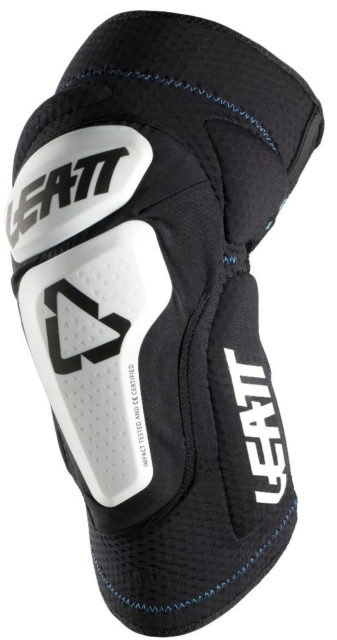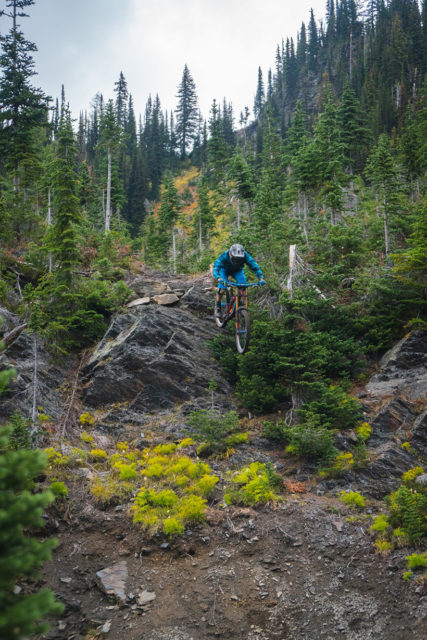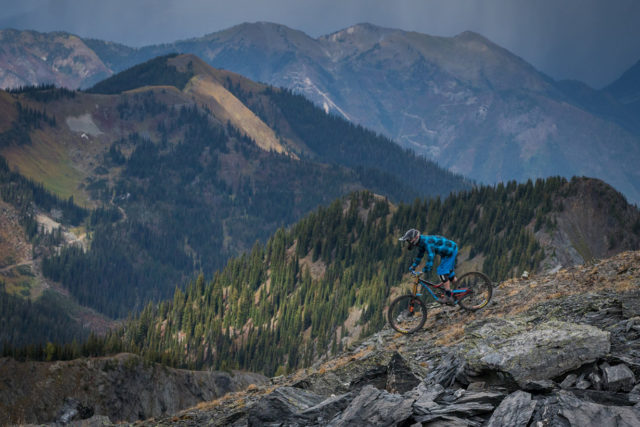Leatt 3DF 6.0 Knee Guard
Reviewer: 5’9”, 155 lbs
Size Tested: S/M
Stated Features:
- Total Leatt® protection score of 21 points
- Soft knee guard with co-molded hard shell sliders
- 3DF AirFit ventilated soft impact foam
- CE tested and certified as impact protection: Knee EN1621-1
- New anti-slip calf band and silicone grip lining
- Silicone printed and adjustable non-slip leg straps
- New anti-odor MoistureCool and AirMesh wicking fabrics
- Pre-curved 3D design for optimal fit
- Side impact protection
Blister’s Measured Weight (size S/M, weight for the pair): 494 g
MSRP: $89.99
Intended Use: DH Knee Protection
Test Locations: Northwest U.S.; British Columbia
Test Duration: ~4 months
Intro
These days, there are a few different ways to categorize knee pads: slim pull-on pads for long rides with lots of pedaling; burly pads for lift-served downhilling; soft pads with materials that harden on impact; hard pads that protect via a plastic shell, and so on. There are a lot of options.
The Leatt 3DF 6.0 combines features from a few of those categories into one pad, which makes for an interesting option, but also one where I wasn’t quite sure what kind of riding it’d be best for. So I spent a whole bunch of time in them, and here’s what I discovered.
Fit
I’m usually pretty safely a Medium. It doesn’t typically matter what it is — pants, shirts, knee pads, helmets — I’m a Medium.
Now, by Leatt’s sizing chart, I should technically be in a L/XL knee pad (my leg circumference measures about 17” above the knee). But from past experience with Leatt products, I’ve found that they tend to run a bit big, and that holds true with the 3DF 6.0 pads. So I sized down to the S/M, and the fit was good — snug, but not uncomfortably tight. So I’d recommend the same to anyone else — if you’re at the small end of the sizing range, you might be better off sizing down for the 3DF 6.0.
Construction and Protection
I’ve used a bunch of pads that utilize the 3DF material (or some approximate equivalent to it). It’s neat stuff that’s malleable like clay, but when it takes an impact, it hardens up immediately. This makes for a knee pad that’s more flexible and feels better while pedaling, but that still offers pretty good protection.
I’ve also used a bunch of pads that have a hard plastic shell. These tend to be less pedal-friendly, but they protect really well. And most importantly for me, the hard-plastic pads slide nicely so that when you hit the ground, the pads don’t hang up and get pulled down to your ankles, leaving your knees exposed.
The 3DF 6.0 pads feature both materials — the meat of the pad’s protection is 3DF impact foam, but it’s capped with a plastic hard shell to help with sliding. The result is a pad that’s a bit less stiff than the pads that only use a plastic shell, but it still gets the benefits of being able to slide during a fall.
The sides of the knee on the 3DF 6.0 are also protected with some relatively thin foam — it’s not the kind of thing that can take a huge impact, but it’ll help, and it doesn’t restrict mobility too much.
The 3DF 6.0 is secured with a single elastic / velcro strap at the top, and a generally snug fit at both the upper and lower cuff. There are also large strips of silicone grippy stuff at both the upper and lower cuffs. I found the pad to be snug and grippy enough that the elastic strap almost felt unnecessary — the pad stayed put pretty well even with the strap loose.
In terms of length, I’d call the 3DF 6.0 “medium-long” by dedicated knee-pad standards. It doesn’t get into the territory of a combination knee / shin pad, but it covers a few inches below my knee, which is quite a bit more than some of the more pedaling-oriented knee pads.
On The Trail
As I said at the outset, I wasn’t entirely sure if the 3DF 6.0 was going to be a pad that I only used for lift-served riding, or if it’d also work for pedaling ventures. My conclusion: it’s mostly for lift-served and shuttled riding.
In terms of mobility, it’s actually pretty decent. The 3DF material does its thing, meaning that it doesn’t feel overly restrictive. But there’s a lot of padding pretty much everywhere except for the back of the pad, and that makes the 3DF 6.0 quite warm to pedal in.
And while mobility was relatively good, I did still get some chafing when I went for longer, pedal-y rides in them (although some of that might have just been because my knee was sweating a lot). Most of that chafing was at the back of my knee, and in fairness to the Leatt pads, it’s a rare pad that doesn’t rub me wrong back there. I should note that there’s a good pocket of space in front of the knee, so I didn’t get any chafing or pressure on my knee cap while pedaling.
So compared to a more pedal-friendly “Enduro” type pad, the 3DF 6.0 probably runs too hot for most people. But by Downhill-pad standards, it’s pretty average in terms of warmth, and a bit above average in terms of mobility.
I also found that, while the big silicone strips at the cuffs were great for keeping the pad in place, they also trapped a bunch of sweat against my leg. During one particularly hot week in Whistler where I was using the pads every day, I actually started to get a rash where the silicone was. This might have happened with any other knee pad as well (since most pads use silicone for grip), but the 3DF 6.0 pads use more silicone than most.
But generally speaking, for lift-served and shuttle laps, the 3DF 6.0 pads have a lot to like. They have (most of) the comfort of a more pedal-oriented 3DF pad, but also have (most of) the protection and slide-iness of a hard-shell pad. And on top of that, there’s a bunch of extra padding around the “main” pad that’ll almost certainly keep the sides and top of your knee in better shape when it’s flopping around and smashing into stuff during a crash. I also found those side pads to be nice just for the occasion when I somehow managed to smack the side of my knee into the toptube.
Bottom Line
The knee pad landscape is pretty good right now — there are lots of options to choose from, regardless of how you intend to use them. If you’re in the market for something that’s a bit more dedicated to downhill and shuttle use, Leatt’s 3DF 6.0 is a solid option. It offers up protection that’s as good, if not better than other DH knee pads I’ve tried, but it does it in a package that’s still pretty comfortable to move around in. And on cooler days, they’re not bad to pedal in (at least by bulkier, more protective knee-pad standards). The combination of the 3DF impact foam with a hard outer shell is kind of a “best of both worlds” scenario, and it’s solidly executed here.





Hi Noah,
Good thorough review, thanks.
But Can you take the polymer dough out to wash the pads? That stuff seems to harden a lot if it gets in 30C water.
Some makers say wash pads cold but crikey, what about the stench?
Thanks man
Enjoy the December break
cold water and soap cures stench pretty much as well as hot.
The trick is the detergent…;-)